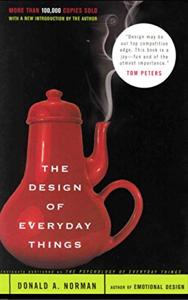
Want to learn the ideas in The Design of Everyday Things better than ever? Read the world’s #1 book summary of The Design of Everyday Things by Don Norman here.
Read a brief 1-Page Summary or watch video summaries curated by our expert team. Note: this book guide is not affiliated with or endorsed by the publisher or author, and we always encourage you to purchase and read the full book.
Video Summaries of The Design of Everyday Things
We’ve scoured the Internet for the very best videos on The Design of Everyday Things, from high-quality videos summaries to interviews or commentary by Don Norman.
1-Page Summary of The Design of Everyday Things
Overview
Don Norman’s book The Design of Everyday Things focuses on understanding the relationships between people and the tools they use. His insights are based on his experiences working with famous designers, such as Steve Jobs. He also reviews research in cognitive psychology and other disciplines to explain why some products work well while others don’t.
Designers should always focus on the needs of the user. They should make it as easy as possible for humans to use their machines. When problems occur, they are not due to user error but rather flaws in design and usability.
Two concepts in design are discoverability and affordance. Discoverability is the ease with which an object communicates its own capabilities, while affordances vary from person to person. For example, a staircase doesn’t provide the same affordance to someone who uses a wheelchair as it does for someone who walks.
When people approach an object, they don’t always know how to use it. The designer’s job is to bridge the gap between what users understand and what they need to do in order to use that item properly. This can be done by providing signifiers or cues (small hints) along the way on how to operate the object.
People make errors when using a product. Some of those errors are deliberate and some are not. Experts tend to make slips, because they know what to do but just forget or mis-click. Novices often make mistakes because they don’t understand the interface correctly and end up doing something wrong, even though it was their intention to do something right. In any case, it’s best if you can prevent these errors from happening in the first place by designing your product well; however, since people will inevitably make mistakes anyway, you should also design ways for them to recover from those mistakes gracefully as well.”
Designers use the double-diamond model of design. First, they expand their thinking to consider all possible causes for a problem. Then, when one source is identified, they narrow their options down to a tailored solution.
Usually, designers have to deal with constraints, such as budgets and timelines. They must also keep in mind the end user’s needs. In addition, marketers are involved from the beginning of a project so that they can help make sure products are not just usable but marketable. Even with their input, sometimes well-designed products fail because the market isn’t ready for them yet. Such failures shouldn’t be considered dead ends; rather they’re learning experiences that will inform better designs in the future if you have an appropriate attitude about them and learn from your mistakes.
Key Point 1: Designers should place the end user’s experience above all else as they create.
Designers don’t create products; they create experiences. They have to anticipate problems and recognize pain points in the design process. Most innovative designers rethink a product or service from the ground up, as evidenced by PillPack, which Amazon bought for $1 billion in June 2018.
PillPack began by recognizing that pharmacies often don’t provide a good experience to the user. Long lines can be unpleasant, and even dangerous for patients who are very sick. As an online pharmacy, PillPack eliminates the pick-up process altogether, delivering its product to people’s homes.
PillPack’s design seeks to solve a problem that many people experience. It is related to taking medicine and compliance. Many people in the United States take five or more prescriptions every month, but they sometimes forget to take their medication on time, which can have health consequences as well as financial ones because of costs incurred by both patients and insurers if the drugs are not taken properly.






